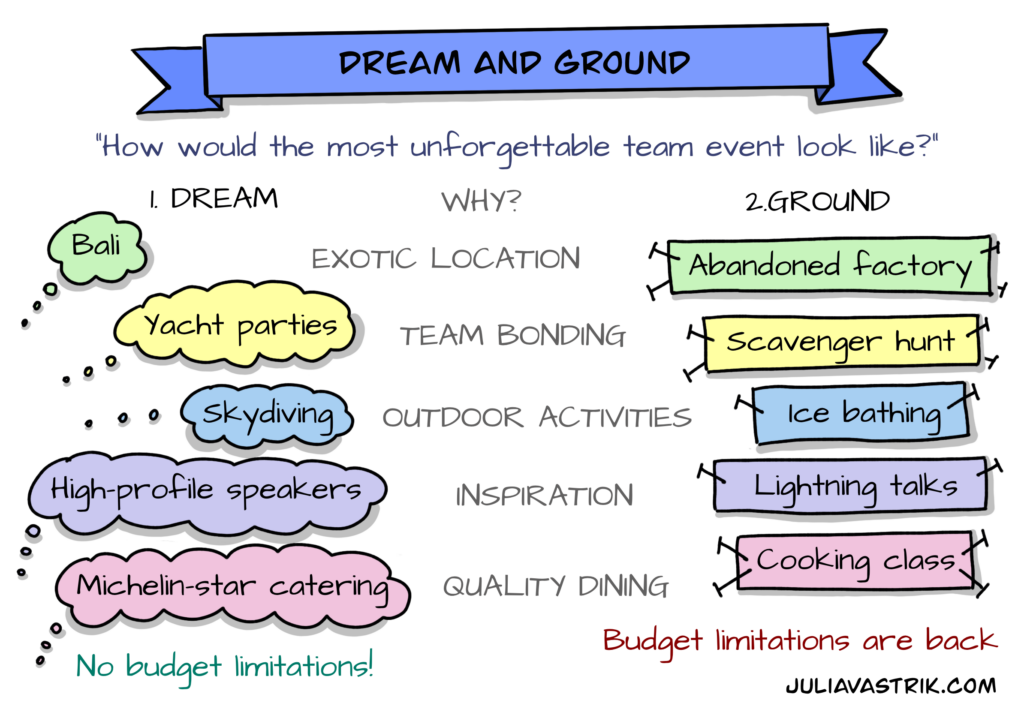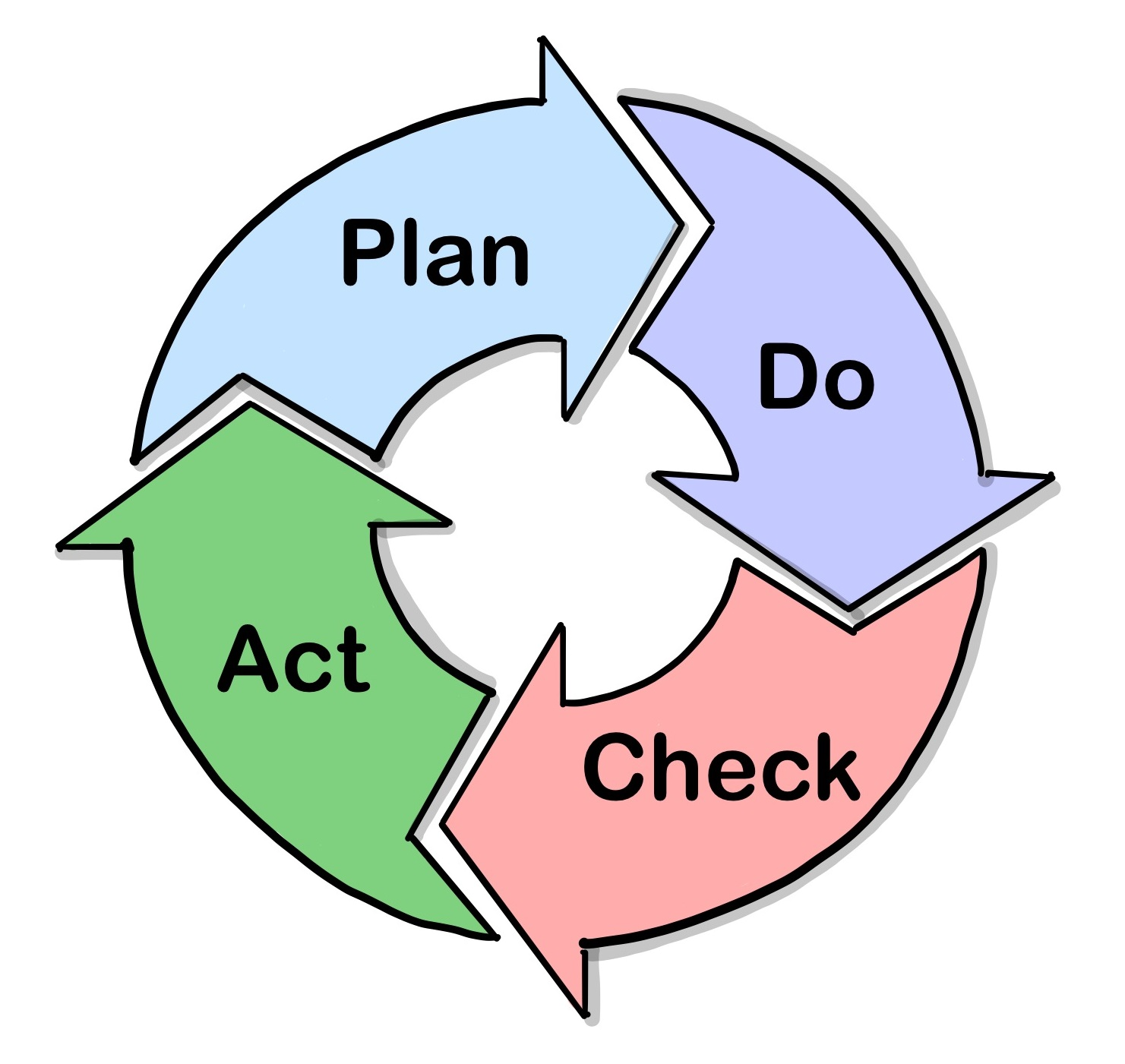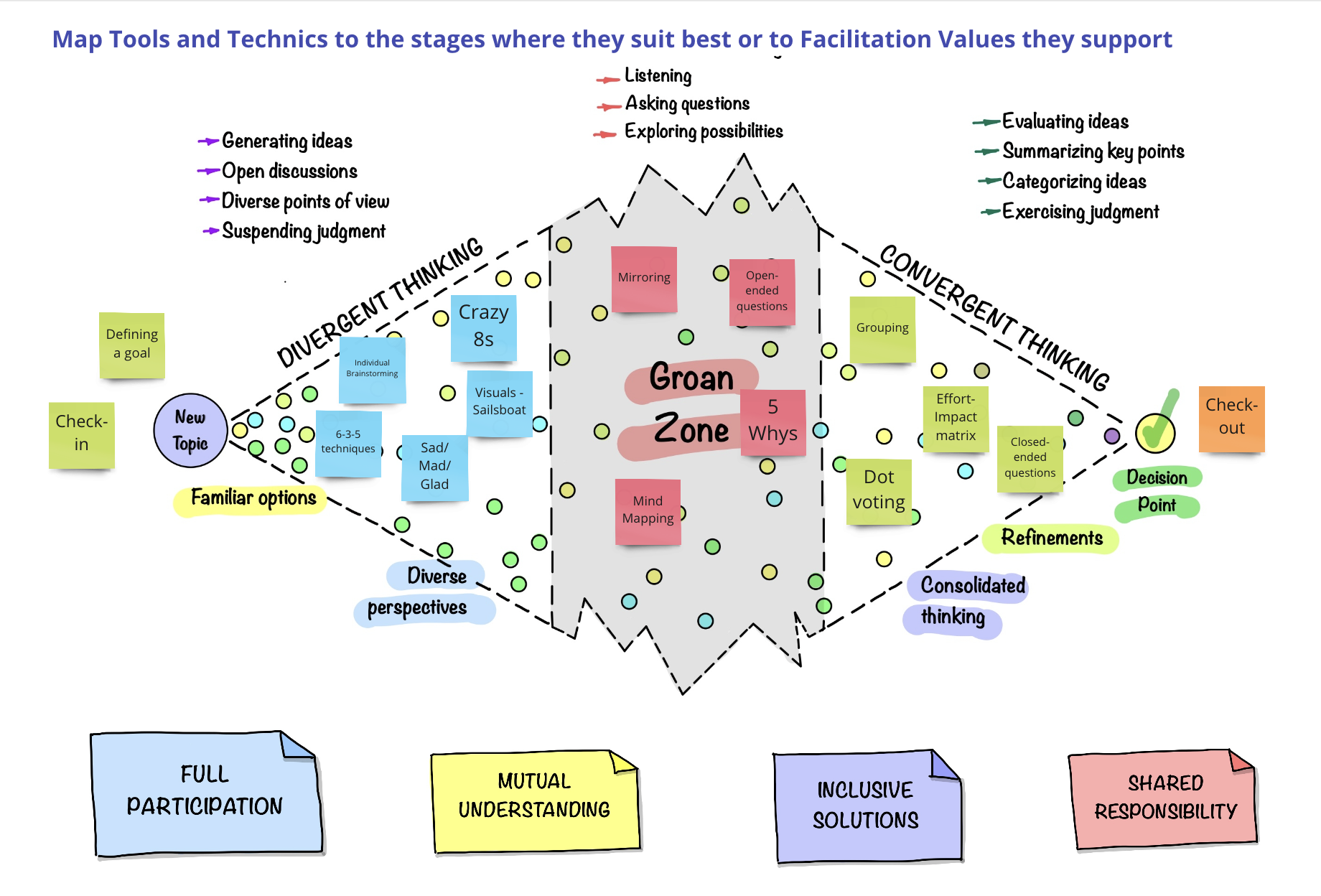Constraints are an unavoidable part of the real world. We never will have enough time, budget, or other resources. This is a reality that we have to accept. However, the problem is that too often those constraints severely influence the way we think, shaping our ideas and limiting our creativity, which results in boring, ‘business-as-usual’ solutions.
This is where the Dream and Ground technique can help break through those limitations.
The key lies in temporarily suspending constraints—such as imagining an unlimited budget or no time restrictions—to enable unconstrained ideation. Once bold ideas have emerged, the constraints are reapplied, allowing teams to extract the strongest aspects of those ideas and refine them into feasible, practical solutions.

What is Dream and Ground?
Dream and Ground is a two-step ideation process that encourages unconstrained creativity followed by down-to-earth refinement. It works by first removing limiting constraints to generate bold ideas (the “Dream” phase) and then reintroducing those constraints to extract the strongest elements and shape them into more feasible solutions (the “Ground” phase).
The process consists of two steps:
- Unbounded Ideation: Remove limiting factors to encourage radical, boundary-free thinking.
- Selective Reapplication: Reintroduce constraints and distill the essence or core strengths of initial ideas to craft practical, realistic solutions.
During the second step, I especially like the idea of distilling the essence or core strength of the initial “wild ideas” with unlimited possibilities. Asking questions like, “What makes this idea so great?” and then, “How can we achieve the same impact with what we have?”
- You might not be able to take your team to Bali, but an abandoned factory can feel just as exotic, right? 😅 - No yachts? A scavenger hunt in that abandoned factory might be just as much fun — and no seasickness involved! 🙌 -And ice bathing might serve as an excellent team bonding and outdoor activity - especially when you’re all freezing in the same water! 🧊 By blending visionary creativity with pragmatic refinement, Dream and Ground enables more creative problem-solving within real-world limitations.
How Does It Work?
The process is simple but powerful. Here’s a breakdown:
- Dream Phase – Remove Constraints
Free unlimited ideation.- Start by identifying the primary constraints limiting your current solutions. This could be budget, time, resources, or technology.
- Now, suspend those constraints. Ask yourself or your team, “What if we had an unlimited budget?” or “What if time wasn’t a factor?”
- Encourage big, bold ideas without worrying about feasibility. No idea is too wild during this phase.
- Ground Phase – Reapply or Modify Constraints
This phase is about extracting the strongest elements from the initial ideas and reshaping them into realistic solutions that fit within the constraints.- After generating ideas, extract the essence or core strengths of the boldest solutions. Identify the most impactful, feasible components – what makes them so great?
- Reintroduce the original constraints. Ask, “Now that we’re back to having budget X or time Y, how can we preserve the essence of these ideas? What adaptations or compromises can we make to ensure the strongest elements remain intact? How can we achieve the same impact with what we have?”
- Consider scaling down, combining elements, or finding simpler alternatives that still capture the spirit of the original ideas. This phase is about creatively navigating constraints to transform ambitious concepts into practical, actionable solutions.
Example
Scenario 1: Team Event Planning with Unlimited Budget
- Dream Phase: The team envisions an extravagant retreat at an exotic location, featuring luxury accommodations, Michelin-star catering, high-profile guest speakers, and adventure activities such as skydiving and yacht parties.
- Ground Phase: With a limited budget, the team focuses on replicating the essence of these elements:
- Identify key strong elements:
- Team Bonding: Unique shared experiences such as outdoor sports and adventure activities.
- Inspiration: Engaging keynote speakers or workshops that leave lasting impact.
- Quality Dining: Memorable meals that foster connection and enjoyment.
- Replicate those elements within the limited budget:
- Host the event at a local venue or nature retreat.
- Find volunteers within the team to lead workshops or share their expertise, or invite external speakers for select sessions who are happy to join for the experience and good company – such as friends of friends.
- Incorporate affordable team-building activities like hiking, scavenger hunts, or other simple activities that can be organized by team members or done for free.
- Opt for a fun and collaborative cooking class together, led by a team member, where the team can bond while preparing their own meal and enjoy a high-quality meal afterward.
- Identify key strong elements:
The result? A grounded, impactful team event that maintains the core strengths of bonding, inspiration, and quality, even within serious budget constraints.
Scenario 2: Enhancing Customer Support with Unlimited Budget
- Dream Phase: The team envisions a luxurious customer support experience with personalized AI-driven assistance, 24/7 human agents, and concierge-level service for every client.
- Ground Phase: With budget constraints back in place, the team identifies key elements that can be scaled down:
- Personalized Support: Retain AI-driven elements but simplify them into a dynamic FAQ chatbot that evolves with user feedback.
- Human Touch: Maintain human agents but limit live support to high-value or premium clients.
- Enhanced Automation: Automate basic inquiries while reserving personalized interactions for complex cases.
The result? A cost-effective but enhanced customer experience, grounded in realistic capabilities but inspired by the dream scenario.
Facilitation tips
- It is better if the team members don’t know in advance that after the Dream phase, there will be a Ground phase, so as not to limit their creativity.
- During the Ground phase, emphasize preserving the spirit of the initial ideas, even if they need to be scaled down. The goal is not simply to revert to the original constraints but to adapt and refine ideas in a way that retains their most valuable and impactful elements.
Dream and Ground works well in team environments, particularly in brainstorming sessions, design sprints, and strategy meetings. It encourages participation, removes fear of failure, and drives engagement by allowing individuals to think beyond limitations.
The Dream and Ground techniques help unleash creativity while clarifying what is really important to us.
Creativity isn’t about having unlimited resources—it’s about making the most of what you’ve got.
For more tools and techniques, see: Facilitation and Brainstorming

